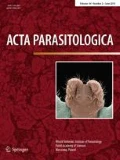Abstract
Purpose
The giant liver fluke, Fascioloides magna, is an important parasite of white-tailed deer (Odocoileus virginanus), a commercially important game species in the northeastern United States. However, the parasite has never been genetically characterized from this region and so its genetic interrelationships with other enzootic populations on the continent are unknown. The purpose of this study was to genetically characterize F. magna from the Adirondack region of northern New York (NNY) and determine its relationship with its enzootic cohorts.
Methods
Flukes were extracted from seven livers of O. virginanus at three localities in and around the Adirondack Park in northern New York. DNA was extracted from eight individuals using standard procedures, and a 440-bp fragment of the COI gene was amplified using species-specific primers. F. magna sequences generated from a previous phylogeographic study were obtained from the GenBank database and a mtDNA dataset was compiled, aligned, and edited for molecular analyses. Analyses based on eight mtDNA sequences included haplotype network reconstruction, along with hierarchical and pairwise (ФST) AMOVA tests.
Results
F. magna from the Adirondacks was found to be most genetically similar to specimens from Minnesota based on shared haplotypes and relatively low genetic differentiation (ФST = 0.331). East coast enzootic populations exhibited panmixia while their west coast cohorts were genetically distinct.
Conclusion
Based on the strong genetic similarities between F. magna from northern New York and Minnesota, we propose that the GLR enzootic range of F. magna be extended to encompass the Adirondack region of NNY.


Data availability
All sequences were deposited into the GenBank database (MT158313–MT158320).
References
Avise JC (2004) What is the field of biogeography and where is it going? Taxon 53:893–898. https://doi.org/10.2307/25065345
Avise JC (2009) Phylogeography: retrospect and prospect. J Biogeogr 36:3–15. https://doi.org/10.1111/j.1365-2699.2008.02032.x
Renaud F, Clayton D, de Meeus T (1996) Biodiversity and evolution in host-parasite associations. Biodivers Conserv 5:963–974. https://doi.org/10.1007/BF00054414
Schulte RD, Makus C, Schulenburg H (2013) Host-parasite coevolution favours parasite genetic diversity and horizontal gene transfer. J Evol Biol 26:1836–1840. https://doi.org/10.1111/jeb.12174
Lajeunesse MJ, Forbes MR (2002) Host range and local parasite adaptation. Proc R Soc Lond Biol 269:703–710. https://doi.org/10.1098/rspb.2001.1943
Dunn AM (2009) Parasites and biological invasions. Adv Parasit 68:161–184. https://doi.org/10.1016/S0065-308X(08)00607-6
Lafferty KD (2012) Biodiversity loss decreases parasite diversity: theory and patterns. Philos Trans R Soc B 367:2814–2827. https://doi.org/10.1098/rstb.2012.0110
Kralova-Hromadova I, Bazsalovicsova E, Stefka J, Spakulova M, Vavrova S, Szemes T, Tkach V, Trudgett A, Pybus M (2011) Multiple origins of European populations of the giant liver fluke Fascioloides magna (Trematoda: Fasciolidae), a liver parasite of ruminants. Int J Parasitol 41:373–383. https://doi.org/10.1016/j.ijpara.2010.10.010
Bazsalovicsova E, Kralova-Hromadova I, Stefka J, Minarik G, Bokorova S, Pybus M (2015) Genetic interrelationships of North American populations of giant liver fluke Fascioloides magna. Parasites Vectors 8:288. https://doi.org/10.1186/s13071-015-0895-1
Foreyt WJ, Todd AC (1976) Development of the large American liver fluke, Fascioloides magna, in white tailed deer, cattle and sheep. J Parasitol 62:26–32. https://doi.org/10.2307/3279036
Pybus MJ (2001) Liver flukes. In: Samuel WM, Pybus MJ, Kocan AA (eds) Parasitic diseases of wild mammals, 2nd edn. Iowa: Iowa State University Press, Ames
Dunkel AM, Rognlie MC, Rob Johnson G, Knapp SE (1996) Distribution of potential intermediate hosts for Fasciola hepatica and Fascioloides magna in Montana, USA. Vet Parasitol 62:63–70. https://doi.org/10.1016/0304-4017(95)00859-4
Larkin AM, Beier CM (2014) Wilderness perceptions versus management reality in the Adirondack Park, USA. Landscape Urban Plan 130:1–13. https://doi.org/10.1016/j.landurbplan.2014.06.003
Dwyer JF (1976) Preservation of wilderness: Adirondack issues and prospects. J For 74:692–694. https://doi.org/10.1093/jof/74.10.692
Cheatum EL (1951) Disease in relation to winter mortality of deer in New York. J Wildlife Manag 15:216–220. https://doi.org/10.2307/3796614
Naem S, Budke CM, Craig TM (2012) Morphological characterization of adult Fascioloides magna (Trematoda: Fasciolidae): first SEM report. Parasitol Res 110:971–978. https://doi.org/10.1007/s00436-011-2582-2
Kralova-Hromadova I, Spakulova M, Horackova E, Turcekova L, Novobilsky A, Beck R, Koudela B, Marincullc A, Rajsky D, Pybus M (2008) Sequence analysis of ribosomal and mitochondrial genes of the giant liver fluke Fascioloides magna (Trematoda: Fasciolidae): intraspecific variation and differentiation from Fasciola hepatica. J Parasitol 94:58–67. https://doi.org/10.1645/GE-1324.1
Hall TA (1999) BioEdit: a user-friendly biological sequence alignment editor and analysis program for Windows 95/98/NT. Nucleic Acids Symp Ser 41:95–98
Leigh JW, Bryant D (2015) popart: full-feature software for haplotype network reconstruction. Methods Ecol Evol 6:1110–1116. https://doi.org/10.1111/2041-210X.12410
Exoffier L, Lischer HE (2010) Arlequin suite ver 3.5: a new series of programs to perform population genetics analyses under Linux and Windows. Mol Ecol Resour 10(3):564–567. https://doi.org/10.1111/j.1755-0998.2010.02847.x
Ellsworth DL, Honeycutt RL, Silvy NJ, Bickham JW, Klimstra WD (1994) Historical biogeography and contemporary patterns of mitochondrial DNA variation in white-tailed deer from the southeastern United States. Evolution 48:122–136. https://doi.org/10.1111/j.1558-5646.1994.tb01299.x
Marrotte RR, Bowman J, Wilson PJ (2020) Climate connectivity of the bobcat in the Great Lakes region. Ecol Evol 10:2131–2144. https://doi.org/10.1002/ece3.6049
Jokinen EH (1992) The freshwater snails (Mollusca: Gastropoda) of New York State. University of the State of New York, State Education Department, New York State Museum, Biological Survey, p 112
Kralova-Hromadova I, Juhasova L, Bazsalovicsova E. The giant life fluke, Fascioloides magna: past, present and future research. Springer briefs in animal sciences, 1st edn. Springer, Switzerland, p 106. https://doi.org/10.1007/978-3-319-29508-4 (ISBN 978–3–319–29506–0)
Acknowledgements
The authors are grateful to Prof. Michael Twiss for providing samples of the giant liver fluke for initial identification and analyses. Special thanks also go to the hunting community of New York for providing additional samples for analyses.
Funding
Not applicable.
Author information
Authors and Affiliations
Contributions
AAD and AP both carried out DNA extraction and PCR amplification, AP mined the sequence data and analyzed the compiled dataset, AAD reviewed the analyses, and both AP and AAD wrote the manuscript.
Corresponding author
Ethics declarations
Conflict of interest
The authors declare that they have no conflict of interest.
Additional information
Publisher's Note
Springer Nature remains neutral with regard to jurisdictional claims in published maps and institutional affiliations.
Rights and permissions
About this article
Cite this article
Parker, A., David, A.A. Genetic Characterization of the Giant Liver Fluke, Fascioloides magna (Platyhelminthes: Fasciolidae) From the Adirondack Region of Northern New York. Acta Parasit. 66, 259–263 (2021). https://doi.org/10.1007/s11686-020-00256-5
Received:
Accepted:
Published:
Issue Date:
DOI: https://doi.org/10.1007/s11686-020-00256-5

